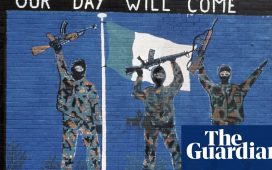A new menace now threatens the world’s warring factions. Who would have thought balloons would raise such a ruckus? Think about it, though. Just about any country, or any terrorist grouping, should be able to launch a balloon.
In the spectrum of weaponry, balloons rank at the opposite end from nukes and missiles. South Korea’s defense ministry has just restored North Korea to its place as the “enemy” in its annual white paper. That’s a reflection of the dangers posed by North Korea’s nukes and missiles, not balloons or drones. The South’s conservative president, President Yoon Suk-yeol, reversed the policies of the outgoing president, Moon Jae-in, who thought it would not be a good idea to call North Korea the “enemy” while pursuing reconciliation.
That quest, of course, was futile considering the refusal of North Korea’s leader, Kim Jong Un, to see Moon after the failure four years ago of the Hanoi summit between Kim and Donald Trump, who insisted the North had to give up its nuclear program. He foolishly expected that to happen after meeting with Kim in Singapore the previous June. Now, President Biden, whatever he thinks of Trump, is making the same demand. All that has changed is that South Korea under Yoon is not only much more insistent than was Moon about denuclearization but is also in favor of joint South Korea-U.S. military exercises — unlike Moon, who had countenanced war games only on computers.
In the midst of concerns about nukes and missiles, worries about balloons might seem a welcome relief. Then again, while they may seem relatively harmless, appearances can be deceptive. Instruments carried by balloons can do more than spy on bases and people down below. They also can carry bombs for dropping when directed by their navigators thousands of miles away. Drones can do the same thing but make a lot more noise; they carry much more equipment and are far easier to detect.
It’s hard to believe Americans are just catching up with such seemingly simple devices. How can it be that a Chinese spy balloon, cruising tens of thousands of feet above the earth’s surface, would prove to be the latest weapon in the inventory of great powers?
Nor is it just the Chinese who are launching them. It turns out the U.S. has been playing with them too. It’s safe to assume a number of other nations are getting into the act, discovering the ease with which balloons can soar out of the sight of high-tech gadgetry. Sophisticated star-gazers are able to see anything up there from low-flying satellites to spy planes intruding into air defense identification zones, but balloons may have inexplicably slipped beneath the radar.
The balloon phenomenon has immediate significance for the defense of all countries, none more so than South Korea. North Korea has launched a number of drones over the South. Some have made it back to the North and others have crashed. Think of what the North Koreans can do if tempted to wage balloon warfare against the South. For that matter, shouldn’t the Chinese be expected to launch balloons over other countries, including both North and South Korea? And why shouldn’t South Korea send some balloons over the North?
Come to think of it, defectors from North Korea have been firing balloons from just below the demilitarized zone between the two Koreas over North Korea for years. They’re laden with propaganda leaflets exposing the Kim dynasty and other news and views that North Koreans never get to see or hear. Kim Jong Un’s sister, Yo Jong, has bitterly denounced them, indicating some of them are reaching their intended audience.
South Korean authorities have periodically cracked down on activists for their leaflet campaign, but it’s easy to imagine the South and North engaging in balloon warfare for real, beginning by using them to gather intelligence. Consider the challenge a balloon campaign would present to the South’s air force, madly pursuing balloons right up to the DMZ.
First, though, they’d have to spot them, and that won’t be easy. Not long ago, fighter planes and helicopters were unable to intercept a flight of North Korean drones over the South. Reconnaissance balloons might be still more difficult, especially if they soared thousands of feet into the skies.
For now, American intelligence people need to figure out how the Chinese balloons worked, how much material they were sending back to operators in China, how they controlled their flight patterns, and how valuable they really were as weapons in a new cold war that could turn hot any time.
We’re not even sure if U.S. navy divers off the South Carolina coast have recovered the tiny working parts that are key to the success of the first balloon to be shot down by a missile fired from a U.S. Air Force plane. All we know is the Chinese had been conducting the balloon program for several years before the Americans began to catch up with what they were doing.
The primary responsibility for finding the balloons over North America rests with NORAD, the North American Aerospace Defense Command. Although NORAD may be expected to be able to track the flight of any aircraft approaching the United States and Canada, incredibly, it apparently was caught flat-footed by the appearance of the immense balloon that finally was seen high above Montana.
NORAD physicists, engineers and technicians can “hear” a North Korean nuclear test whenever Kim wants to test one. They’ve been waiting for months for him to order the North’s seventh underground nuclear warhead, but nothing seems to have prepared NORAD for the shock of the Chinese balloons. While focusing on nukes and missiles, no one imagined such relatively simple devices as balloons could capture the attention of statesmen, national leaders, generals and emissaries. Call them China’s once secret weapon.
Balloons are more than merely the stuff of headlines du jour. In a war of wits and nerves as well as strength and power, it’s wise to expect the unexpected, including hot air blowing in from China.
Donald Kirk has been a journalist for more than 60 years, focusing much of his career on conflict in Asia and the Middle East, including as a correspondent for the Washington Star and Chicago Tribune. He currently is a freelance correspondent covering North and South Korea. He is the author of several books about Asian affairs.








